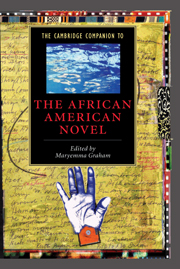Book contents
- Frontmatter
- Introduction
- Part I The long journey
- Part II Search for a form
- Part III African American voices
- 10 Everybody’s protest novel
- 11 Finding common ground
- 12 American Neo-HooDooism
- 13 Spaces for readers
- 14 African American womanism
- 15 Vernacular modernism in the novels of John Edgar Wideman and Leon Forrest
- Bibliography
- Index
- Series List
15 - Vernacular modernism in the novels of John Edgar Wideman and Leon Forrest
from Part III - African American voices
Published online by Cambridge University Press: 28 May 2006
- Frontmatter
- Introduction
- Part I The long journey
- Part II Search for a form
- Part III African American voices
- 10 Everybody’s protest novel
- 11 Finding common ground
- 12 American Neo-HooDooism
- 13 Spaces for readers
- 14 African American womanism
- 15 Vernacular modernism in the novels of John Edgar Wideman and Leon Forrest
- Bibliography
- Index
- Series List
Summary
Recent work in African American literary studies has attempted to define an “Afro-modernism,” an aesthetic position that participates in the project of modernity while not being subsumed by or subordinated to the “high” modernism of the early twentieth century. While Houston A. Baker has identified this practice as “mastery of form/deformation of mastery,” Richard Powell and others have defined it as a “blues aesthetic,” clearly linking it to the African American vernacular tradition. While these are highly useful constructions, they are not quite adequate to much of modern and contemporary black writing. These theorizations have created a “difference from” high modernism when at least some artists - Robert Hayden, Gwendolyn Brooks, and Ralph Ellison are clear examples - have chosen to position themselves within the tradition of T. S. Eliot, James Joyce, and William Faulkner. At the same time, they have also made use of the vernacular tradition, but this should not be surprising, since many of the “high” modernists themselves, whether in poetry, fiction, or the visual arts, found the vernacular to be an important resource.
- Type
- Chapter
- Information
- The Cambridge Companion to the African American Novel , pp. 253 - 267Publisher: Cambridge University PressPrint publication year: 2004
- 1
- Cited by



